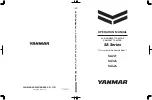
37
Manifold & Cylinder Head
Inspection
1.
Inspect the casting for cracks and burnt metal around the valve ports.
2.
Check the valve seats for cracks and pitting.
3.
Position a lamp underneath the valve guides and examine the bore of the guide for burning,
cracks or signs of excessive wear.
4.
Check the diameter of the guides at several points against the dimensions given I specifications.
5.
If the running clearance between valve and valve guide exceeds 0.2 mm (0.008 in) the valve
guide should be replaced.
6.
Inspect the cylinder head and crank case for warpage if engine has been run with a blown head
gasket
.
7.
Check the valve stems for bends, wear, pitting or mushrooming of the ends. Check the collet
grooves in the stems to ensure they have not lost their shoulders
8.
Check that the valve heads are not excessively worn or pitted.
9.
Check the valve springs for rust, pitting or cracks and against the loads given in specification.
10.
Check the retainers for rust and cracks.
11.
Check and replace valve seals.
12.
Check the outside face and the ribs inside the collects for wear. It is advisable to always use
new collets.
13.
If the new valve guides are replaced, ream the valve guides to the dimensions given in
specifications.
14.
If the valve seat inserts are to be replaced, take a fine cut, if necessary, from the bottom of the
counter bore, to ensure a square seat for the replacement insert.
15.
Thoroughly chill the new valve seat inserts at -60 deg. C in dry ice before installation.
16.
This prevents metal scraping from the side of the counter bore, ensuring full contact of the
insert on the bottom and side of the counter bore. After installation inserts peen over the edge
of the inserts around it’s entire circumstance.
17.
The inserts should be recessed in the Head 0.006” to 0.014”
18.
When using carbon dioxide or dry ice, strictly adhere to instructions to avoid injuries.
19.
Do not touch deep frozen parts with bare hands. Reface the valve seats to the correct angle sea
that are too wide after refacing should be narrowed by grinding the top edge of the seat with
a stone of a similar angle (15 deg angle)
20.
Mount a dial indicator on the pilot shank and check that seat run out does not exceed 0.003”.
21.
Reface the valves but reject valves that grind down to a fine edge.
22.
Using carborundum paste lap-in the valves
23.
Ensure that all carborundum paste is removed from the valve and valve seats after lapping.
24.
Excess paste must be removed with a cloth and the head washed in the solvent and blown
dry with compressed air. Check the valves in their seats using engineers blue. A complete ring
of contact must be shown on both faces.
Содержание Jivo 365 DI
Страница 1: ...1 Mahindra Jivo 365 DI SERVICE MANUAL...
Страница 6: ...4 PRODUCT SPECIFICATION...
Страница 7: ...5 MAINTENANCE...
Страница 12: ...10 GREASING POINTS LOCATIONS...
Страница 18: ...16 ENGINE...
Страница 28: ...26 Manifolds Cylinder Head...
Страница 43: ...41 Timing Gears Camshaft Front Plate...
Страница 51: ...49 Connecting Rods Pistons Cylinder Liners...
Страница 89: ...87 Trouble Shooting...
















































